WORLD CLASS COACHING
Tactical Series
Jurgen Klopp
By Alexander Trukan
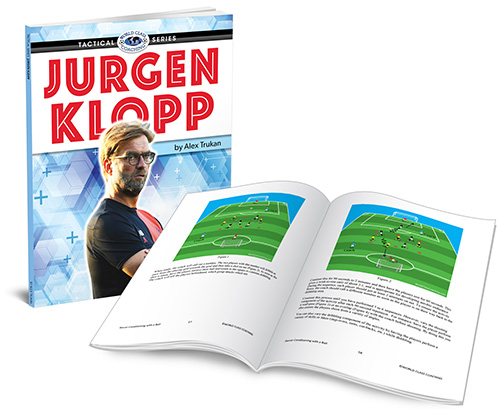
FOREWORD
This short series tactical eBook is focused on giving a little insight into strategies used by one of the coaching masters – Jurgen Klopp. Due to the nature of the eBook format, it is a snapshot of the playing style rather than an extensive analysis of it. The main aim is to present general ideas related to the model of play as well as link this into the training content, which I feel, might help to bring out some of the pictures seen in Klopp’s teams among players you are working with. This is why, I have concentrated on showing principles of play, and less of a patterns of play. Principles of the playing model would be similar for a team throughout seasons. Patterns as well as players used within systems might change from game to game.
The analysis in this eBook has been divided into four phases of the game – attack, transition to defence, defence and transition to attack. Both attacking and defensive phases were further divided into two micro phases. This framework is intuitive and seems natural as this is how football is being played. Although phases are interconnected and some of the aspects of one phase may be dependent on the other, this model provides structure and simplifies the playing model. Every chapter has two training practices included into it.
One of the practices is more of a ‘lead-in’ type, aimed at getting players to understand basic concepts and principles. Second one in turn, is much more context specific, with more players and spaces used. It allows the coach to show pictures which will be similar to those encountered by the players during the match. In the preparation for the analysis, four Liverpool FC matches played between April and August, 2016 have been used.
The presented content, therefore, relates specifically to this period of the season. In light of this, any generalisations, should be made rather cautiously. This, however, does not prevent us from drawing some conclusions about Klopp’s style of play which is fascinating! Enjoy this eBook and play ‘heavy metal’ football!
Alexander Trukan
TABLE OF CONTENTS
Part One
FOREWORD
TABLE OF CONTENTS
INTRODUCTION
KEY CHARACTERISTICS
ATTACKING
Building up from the back
Creating chances and scoring
Training practices
Part Two
TRANSITION FROM ATTACK TO DEFENCE
Training practices
Part Three
DEFENDING
Preventing building up from the back
Preventing creating chances and scoring
Training practices
Part Four
TRANSITION FROM DEFENCE TO ATTACK
Training practices
TOP 10 FOR HIGH INTENSITY SESSIONS
AUTHOR
INTRODUCTION
Jurgen Klopp is known as a ‘konzepttrainer’ in Germany. This means being a coach who sets new directions and introduces novel ideas into methodology. This can be especially seen when watching Klopp’s teams in action – very specific and innovative in the way they play. One of the keys to being a ‘konzept’ coach is evolving. Klopp is no different in this aspect. Since finishing his rather average playing career, he has started to coach for Mainz 05, the club he has made more than 330 appearances for. At that time, under influence of Wolfgang Frank, he has widely used zonal marking and 4-4-2 defending. Then, after joining Borussia, he started to become well known for his ‘gegenpressing’ game, high energy and playing forwards. This style of play has gained him a lot of success, winning two league titles, one cup and two super cups during his 7 seasons at the club.
In October 2015, Klopp has joined Liverpool FC, trying to bring his ideas together and evolve again in a different environment. In addition to high pressing game and intensity, Klopp has heavily insisted on rotation between players when attacking, making his side fluid and difficult to mark and defend against. He has been also stating that it is the type of players he has got are the starting point to any system he uses. It is therefore his role to bring the best out of every individual and play to his strengths. That fluidity is linked to him not using a word ‘formations’ very often when attacking.
It is rather principles than positions that make attacking more effective and unpredictable. ‘Formations’ would be more often used when defending, providing structure as well as helping to overload certain areas and regain the ball back. All in all, it is fair to say that Klopp’s teams are exciting to watch. And that’s not only in the attacking phase. His ‘gegenpressing’ approach and transitions make his teams energetic and interesting to watch when they don’t have the ball as well. As Klopp has recently said: ‘gegenpressing is the best playmaker!’ This eBook will explain this as well as other aspects of his style in four moments of the game.
KEY CHARACTERISTICS
High energy and tempo
Desire to play forward
Forward runs off the ball
Support in front of the ball
Speed and quality of pass
Players positioning between the lines
Fluidity adn rotation of the front players
Fullbacks regularly involved in attack
Assymetrical attacking shapes
Through balls in between center backs into channels between center backs and fullbacks
Gegenpressing (counter pressing)
Doubling up when defending
Aggressive leeway and ball orientated pressing
Compactness when defending
Forcing opponent inside/outside the pitch
Preventing switch play when pressing
Combination play in the final third
Create overloads in central areas around the penalty area
ATTACKING
When in controlled possession of the ball, Klopp’s teams are looking to play forwards at every opportunity. This means choosing vertical passes over horizontal ones, offering support in front of the ball as well as making forward runs off the ball. Having positive attitude and displaying high energy and intensity are key components that enable this style of play to be successful. Klopp has used a variety of different formations in the attacking phase: 4-1-4-1, 4-2-3-1, 4-3-3 or 4-2-2-2. These has changed and adapted not only from game to game but also during games. Rotation and fluidity was the key! Regardless of the formation though, his teams show certain traits which distinguish them from all the other ones.
Building up from the back
When building up from the back, Klopp’s teams show a combination of direct as well as progressive styles. The emphasis, however is placed on getting the ball quickly into the opposition’s final third. If the goalkeeper chooses to play out through the back line, a classical split into the edges of the penalty box is used. This is usually followed by one of the defensive midfielders (in most of the cases – Emre Can or Henderson) dropping between centre backs to form a back three. If this option is used, both of the full backs push up higher into the opposition’s half and are not involved in the build-up in this initial phase. This strategy also tends to be more popular when playing against the opposition with two strikers pressurising the back line.
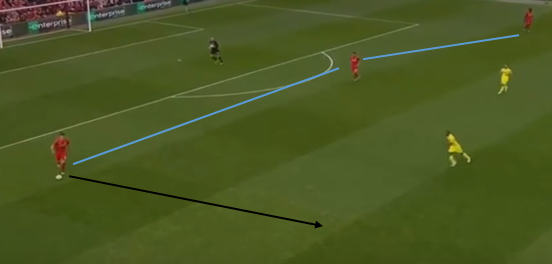
Another option involves one of the defensive midfielders (in this case usually Henderson or Milner) dropping into space between full back and centre back. This is a trigger for the full back on this side to push up higher up the pitch. Getting that full back on the ball usually happens through recycling it into defensive midfielder who then plays wide into full back. More direct option involves a diagonal pass from the opposite side centre back. This option is more often used on the right wing, with Clyne playing in more advanced attacking positions. The opposite side full back will drop deeper and remain in a more defensive position to ensure balance of the back line.
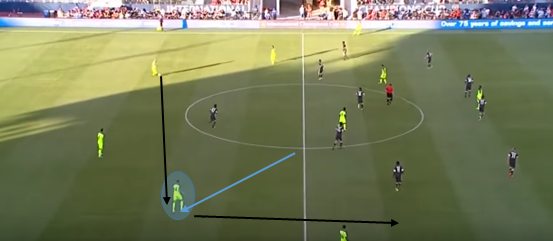
When the ball is in possession on the own half, the most preffered option would be to play to the most advanced striker into space. This role is usually played by Origi, Sturridge or Mane and preffered when playing against the teams using high line with spaces available beyond them.
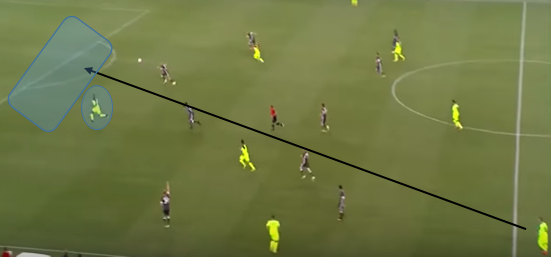
The trigger to start making a run is therefore space in behind and player in possession of the ball able to make a long pass (no pressure around). In order to time the run well as well as cause a zonal marking problem for the defender, a player might choose to curve his run. Body position is crucial in this case which should allow to see the ball as well as make a quick acceleration forwards into space.
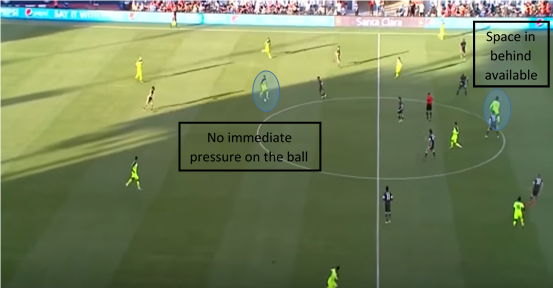
Another direct combination used very often is playing into target player who then extends the pass into two players making forward runs in behind him. These are usually attacking midfielders or false strikers (Lallana, Firmino, Mane, Coutinho). Players used as a target man in this role need to offer immediate support straight after playing the ball in behind. Key areas for this kind of combination are usually spaces on the outside of the opposition centre backs, allowing to penetrate the space between centre back and full back.
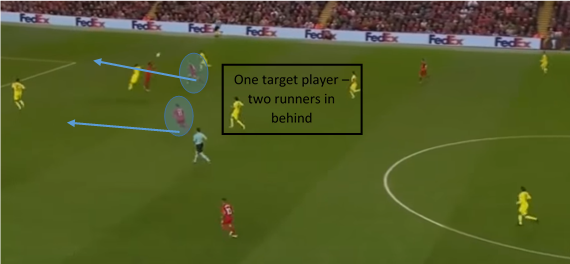
Instead of playing the ball into the forward runners, target play can also choose to hold up the ball and combine with supporting players. Origi is particularly effective in this using his strength and balance to stay on the ball. This option allows quick combination play with attacking midfielders and playing through into the target man who should immediately make a run in behind the back line. Forward runs of the players involved should be in different lines and spaces.
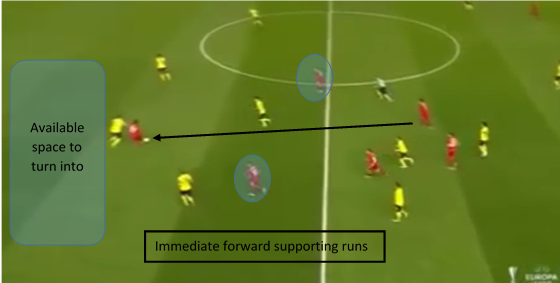
As forward runs are being made from midfield positions (secondary runs), a direct pass can be played in behind to exploit that. These kind of movements are more difficult to defend against as centre backs are occupied by strikers and have to make a decision whether to stay or follow as midfielders will be often late to track the runner. Firmino, Coutinho as well as Mane coming deeper into midfield areas to then make a run are particularly effective in these kind of movements.
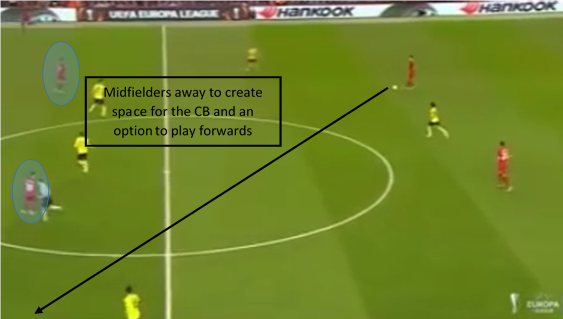
In most of the situations, however, a direct pass into strikers or into space in behind the back line will not be available. Another option preffered by Klopp’s teams in the build up phase is a diagonal ball from centre backs into full backs in advanced positions on the opposition half. This is often used when switching to back three (Emre Can/Henderson dropping in) allowing full backs to push up. Lovren as well as Emre Can are players which are very effective in diagonal passes and switches of play. Clyne and Moreno (less so) are reguarly used to receive beyond opposition’s midfield line and create chances in the final third.
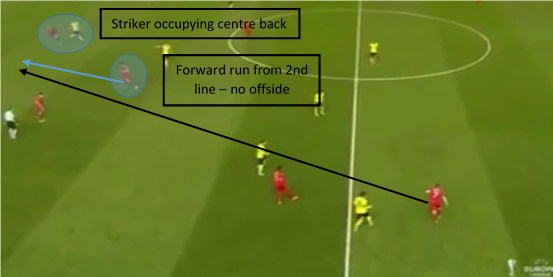
Another way of building up from the back is quick, progressive passing through the central areas. The priority here are through balls that break one or two units of the opposition. In order to allow this, strikers as well as wide and central midfielders are narrowly positioned in central areas (central areas prioritised over wide areas). The key is trying to receive between the lines of the opposition, with the emphasis on turning and penetrating forwards. Players having pace to go in behind as well as finishing ability (Mane, Sturridge, Firmino) look to make a third man run in behind the back line as soon as the ‘playmaking’ player (Coutinho, Lallana) receives the ball and faces forwards.
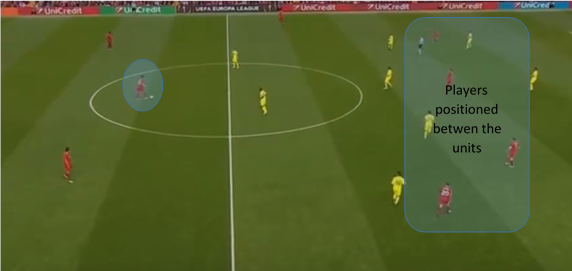
If a direct penetrating pass beyond the opposition’s midfield is not available (i.e. due to opposition being compact and narrow), two midfielders are looking to make a movement towards the ball and try to receive in the space between opposition’s strikers and midfielders.
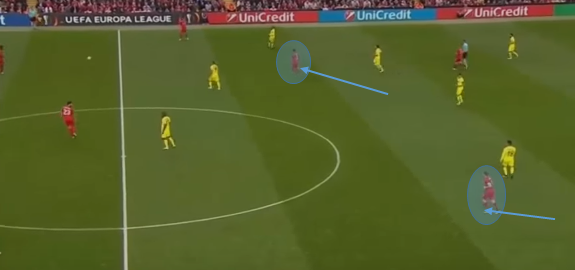
These kind of movements usually involve Lallana dropping on the ball side to play centrally or Milner more on the angle to link play with wide areas. As soon as Lallana gets on the ball, strikers are looking to penetrate in behind the back line.
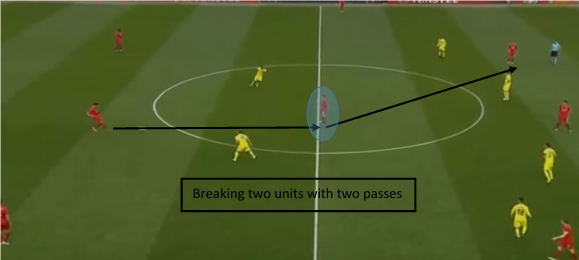
Finally, instead of midfielders, one of the strikers might choose to drop in in front of the back line. This was more evident towards the latter stages of the Klopp’s period at Liverpool, when part of Mane’s role was to pick the ball up from the back line and distribute into one of the full backs positioned wide. This allowed midfielder to offer support in wide areas (as they didn’t have to drop and were positioned higher up the pitch) as well as gave enough time for Mane to make a run back into striker’s role and look to finalize play.
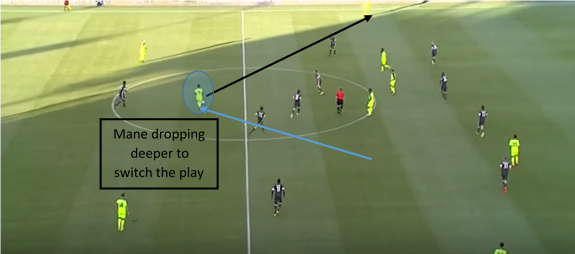
Having different ways of building up from the back as well as being fluid in terms of positions and rotation of players, allowed Klopp’s teams to be successful against different types of defending shapes - pressing high as well as dropping deep into their own half.
Creating chances and scoring
When attacking on the opposition’s half, what we can often observe is relative compactness in the shape. Small distances between the units and players, force the opposition to get more compact. This creates more space in behind to penetrate by a direct pass. Comparing to the build-up play, the distances between the ball and target zone are smaller, what gives less time for the runner to gain advantage over the defender. This is why, quick decision making and acceleration are crucial. Great fit for this role are players like Mane, Ojo or Firmino.
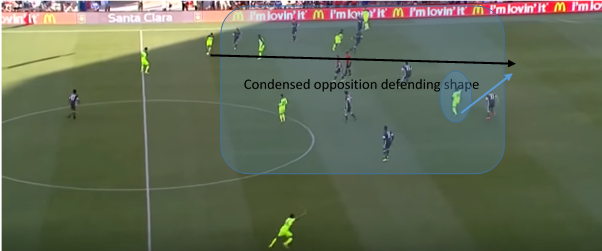
When the direct pass skipping the units is not available, second option used numerous times is getting midfielders on the ball facing forwards just beyond opposition’s midfield line. This allows striker to make a forward run. The key is the timing of the striker’s run. The moment when he begind the run will be dependant on his starting positions. If the striker is positioned deeper into the half, he should start the run as soo as the pass is made into midfielder. In case he is positioned higher up the pitch in line with the opposition back line, the trigger would be midfielder facing forwards and being under no immediate pressure around.
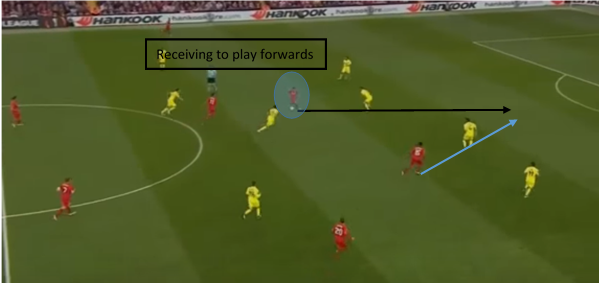
Below, there is an example of a delay forward run from second line. In this case, the run had to be started as soon as the pass is made into midfielder. This type of movement is often used by Mane (described in the building up form the back chapter) who drops deeper first, gets on the ball, distributes it wide and then makes a run forwards as the ball is played from wide areas back to the middle.
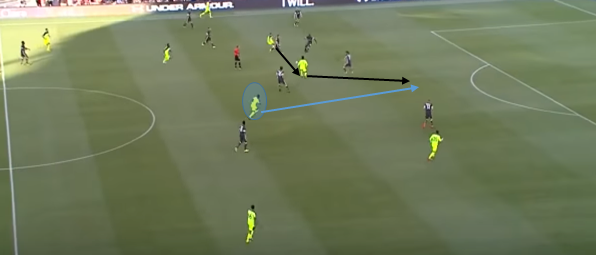
This type of movement might also involve more than one player making a forward run. Two players will cause a further problem for the defending unit. Strikers should aim to start and finish their runs in a different diagonal channel. In other words, the run has to be made on the angle. For example, it might be started between CB and FB and finished between two CB’s.
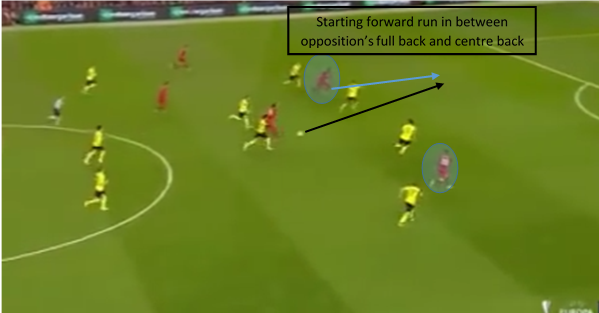
Second option is getting the ball into wide areas, mainly in two types of patterns. First one sees attacking midfielders drifting into wide areas (Coutinho, Lallana, Firmino) to then receive it and combine centrally. Second one involves full back making a forward run and getting it wide with a diagonal pass. In both cases, there is usually left a player in behind the ball who is responsible for distributing the ball into wide areas and switching play (Emre Can, Henderson, Milner).
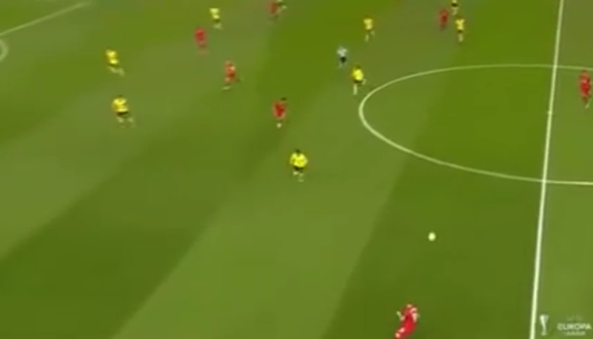
Getting Coutinho and Lallana on the ball in wide areas creates an opportunity for them to drift inside and combine with strikers. It also enables full backs to make overlapping as well as underlapping types of runs and create local overload on the wing. This type of movement tend to be more evident on the left wing, with Moreno combining with attacking midfielders. On the right wing, a more direct approach is preffered, as Clyne receives the ball in advanced positions and tries to create a cross or final pass by himself.
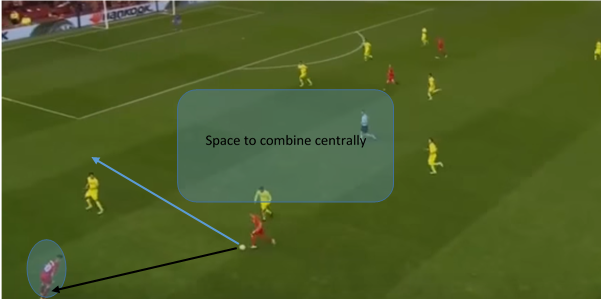
As soon as wide midfielder starts to make an infield movement (emphasis on facing centrally and getting away from the pressure rather than getting past the defender), forward players positioned centrally would be looking to make a run forwards. The area used for these type of runs most often would be between opposition full back and centre back on the ball side. In case two players making runs at the same time, second one would be looking to occupy ‘weak side’ centre back and drag him away from the ball.
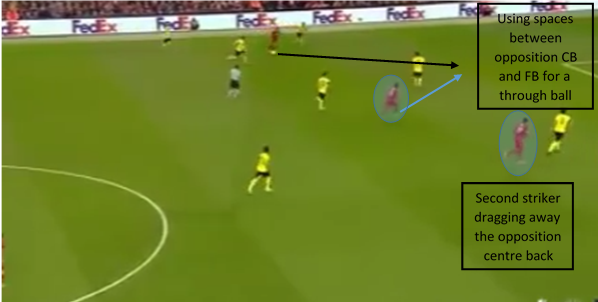
In the situation when the opposition is positioned closer to the own penalty box, and less space is available in behind to penetrate, more rotation between players leading to combination play will be used. Strikers and attacking midfielder would be looking for quick support and playing quickly off one touch to progress forwards. This will usually narrow up the opposition shape and create additional chance to switch play directly on to the opposite side where full back makes a forward run.
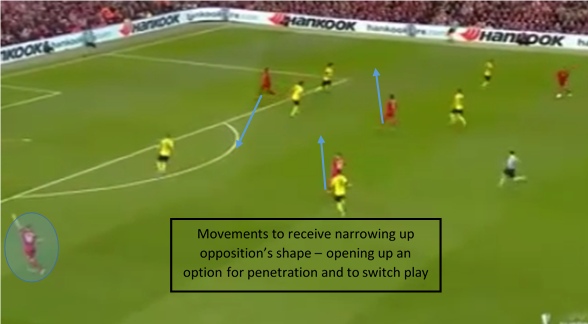
If a player driving inside manages to get closer to the penalty box, through balls to the strikers making a movement against the ball might be used. Firmino is particularly effective in these type of situations, using sharp movement to get away from the defender and finish.
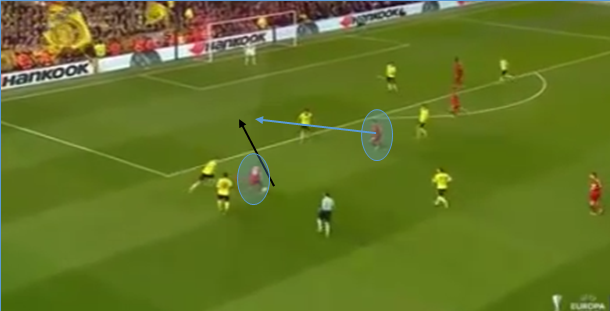
Another pattern that was obvious at times when the ball was wide is overloading central areas of the pitch and isolating wide players. This encourages direct play into the box as well as creates more chances to pass into channel and progress forwards. It also occupies the opposition back line, often creating 3v4 and 4v4 situations which are difficult to deal with from a defending point of view.
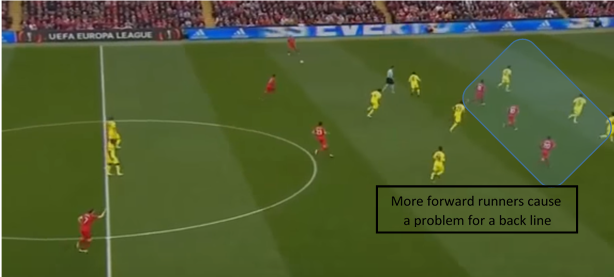
This further links to the situation if the ball gets into the final third and an opportunity for the cross arises. Having more than two players in the box creates more options for a delivery and increases the chances of effective covering of spaces – front post, central areas and far post.
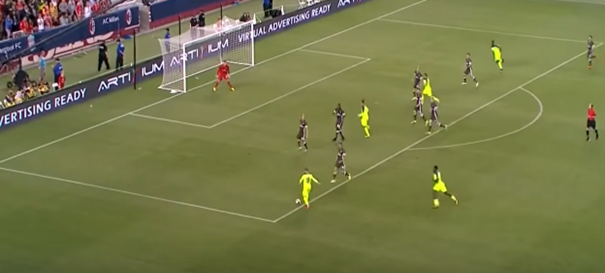
The presented type of attacking strategy requires excellent physical preparation. In particular, speed endurance as well as power are the key components responsible for high quality intensive actions as well as quick recovery between them.
Training practices
Leading in – Small Sided Game 6v6+1
Set up and organization
Organise a pitch of approximately 30 x 40 yards. Further mark out a middle zone of 15 yards in length. Divide the group into two teams of six (5 outfield + 1 goalkeeper). Designate one floater (attacking with a team in possession). Prepare a sufficient amount of balls to ensure tempo and intensity.
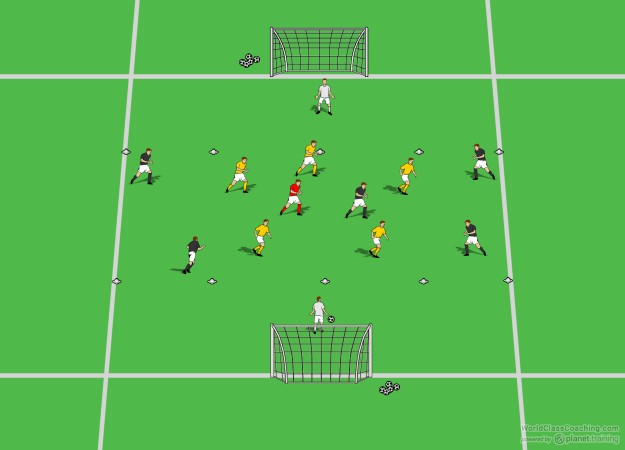
The practice starts from the goalkeeper who plays out the ball to one of his teammates. The game is initially played in the first two thirds of the pitch. Any player can enter the final third only after the ball gets there first. Lines marking out the thirds are also offside lines. The team in possession is working on combinations to play through balls into space in behind. Technical detail to focus on is timing of the run, support, movements off the ball as well as quality of pass.
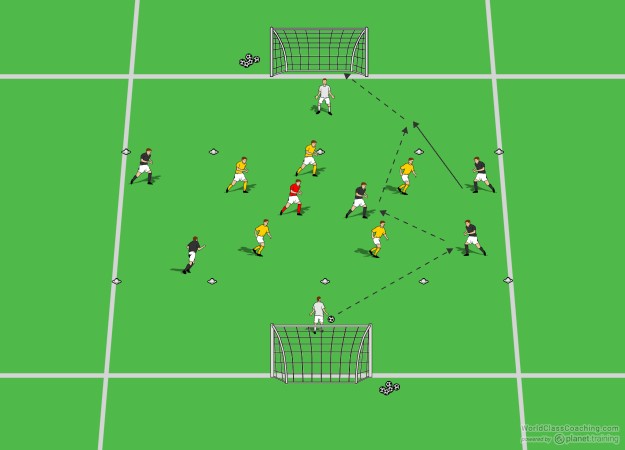
Both teams attempt to score in the opposite goals. There are no corners in this game, the practice is restarted form the goalkeeper. Throw-ins apply. Neutral player support the team in possession to create overload and enable more attacking success. In order to make the practice harder, neutral player might be removed (6v6) or join the team with a defending focus (5v6). This will challenge the attackers to create chances in an underload scenario.
Main part – Phase of Play 9v9+GK
Set up and organization
Mark out a half of a full size pitch. Divide the group into two teams. Attacking team should have 9 players (8 + server positioned behind the half way line), playing with three central midfielders, three forwards (positioned narrowly) and two full backs. Defending team should be playing in a 4-4-1 formation. Regular rules of football, including the offside rule apply. Formation of the opposition can be adjusted to mirror the upcoming opponent (i.e. 4-3-2 or 4-2-3). Prepare a sufficient amount of balls next to the server.
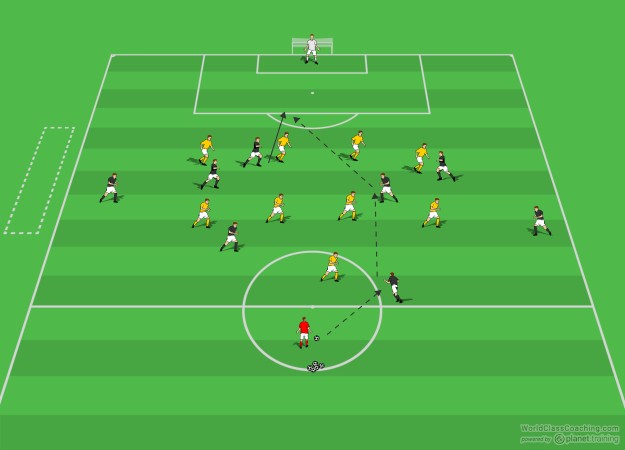
The practice starts with a server playing the ball into of the midfielders from the attacking team. The team should then to find a way to score in the opposite goal as soon as possible. This might be a direct pass behind the back line as well as patient combination play, depending on the situation. Defending team should adjust in relation to the offside line and look to win the ball back as soon as possible.
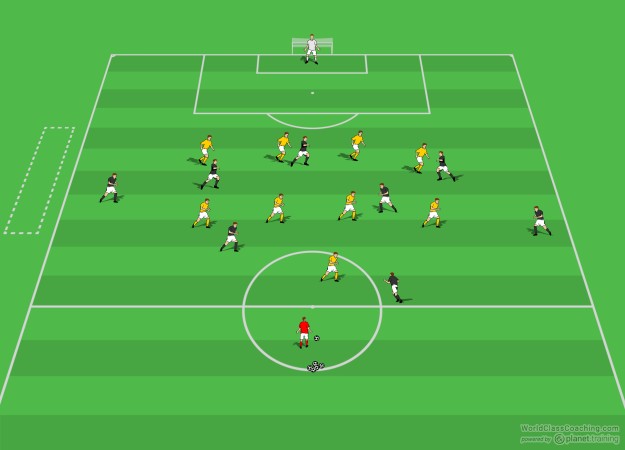
As the defending team gets in possession, it score in two ways – by dribbling the ball through the half way line or by passing the ball into the server. The game is then restarted again from the server playing the ball into the attacking team.
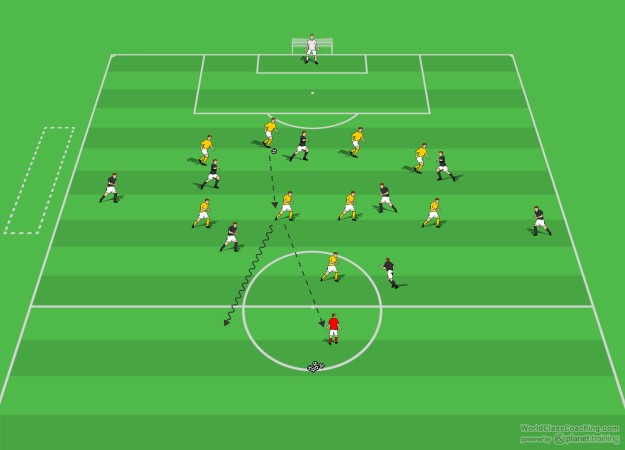
The practice might be progressed into 10v10 phase of play as well as further into 11v11 on a full size pitch. Attacking team might be restricted to certain time for finishing an attack. This will encourage them to play forwards at every opportunity. Also a rule might be added where any passes backwards are disallowed (or two back passes in a row are disallowed to make it easier for the attackers). This will bring out more supporting movements in front of the ball.


